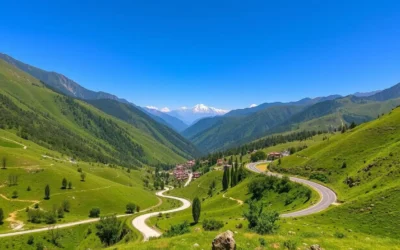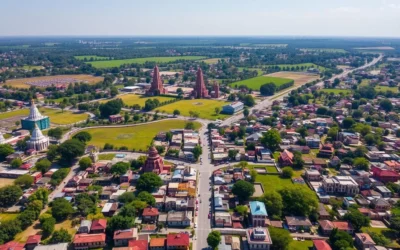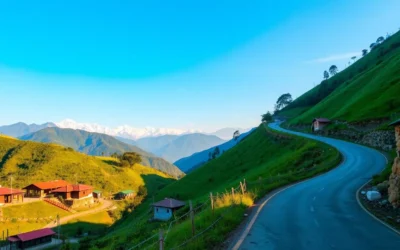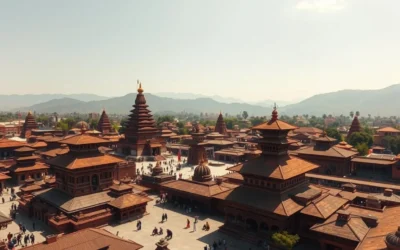✓ Accommodations✓ Flights✓ Rental Cars✓ Tours & Activities
Did you know that over 90% of transactions in Nepal are cash-based? This makes understanding the official currency essential for a smooth travel experience. The Nepalese Rupee (NPR) is the backbone of everyday transactions, and being prepared with the right financial tools can save you time and money.
This guide is designed to help you navigate Nepal’s unique payment landscape. From understanding exchange rates to using ATMs and digital wallets, we’ve got you covered. You’ll learn how to avoid unnecessary fees and plan a smart financial strategy for your trip.
Whether you’re exploring bustling markets or trekking through the Himalayas, carrying NPR is crucial. We’ll also share tips on using travel cards and managing your budget effectively. Ready to dive in? Let’s make your adventure in Nepal as seamless as possible!
Nepalese Currency: An Overview
Understanding the Nepalese Rupee is key to navigating local transactions. Introduced in 1932, it replaced the older Nepalese mohar and has since become the backbone of the economy. Today, it’s essential for everything from market purchases to major expenses.
History and Official Denominations
The Nepalese Rupee has a rich history tied to the country’s modernization. It was introduced during a period of economic reform and has evolved over the decades. The Nepal Rastra Bank oversees its circulation, ensuring stability and trust in the currency.
Banknotes come in denominations of Rs 1, Rs 2, Rs 5, Rs 10, Rs 20, Rs 50, Rs 100, Rs 500, and Rs 1000. Coins are available in 1, 2, 5, and 10 Rupees, with smaller paisa coins also in use. These denominations cater to both small and large transactions.
Understanding Banknotes and Coins
Cash remains the dominant form of payment, especially in rural areas. Smaller notes like Rs 10 and Rs 20 are ideal for local markets, while larger notes are better for hotels or major purchases. Carrying a mix of denominations ensures you’re prepared for any situation.
Here’s a quick breakdown of the most common banknotes and their uses:
| Denomination | Common Uses |
|---|---|
| Rs 10, Rs 20 | Local markets, street food, tips |
| Rs 50, Rs 100 | Mid-range restaurants, transportation |
| Rs 500, Rs 1000 | Hotels, major purchases |
“The Nepalese Rupee is more than just money; it’s a reflection of the country’s history and culture.”
Despite the rise of digital payments, cash is still king in many parts of the region. For travelers, having the right mix of notes and coins can make your journey smoother and more enjoyable.
Understanding Exchange Rates and Conversions in Nepal
Exchange rates can make or break your travel budget, so understanding them is crucial. The value of the Nepalese Rupee fluctuates daily, influenced by global and local economic factors. Staying informed about these changes ensures you get the most out of your money.
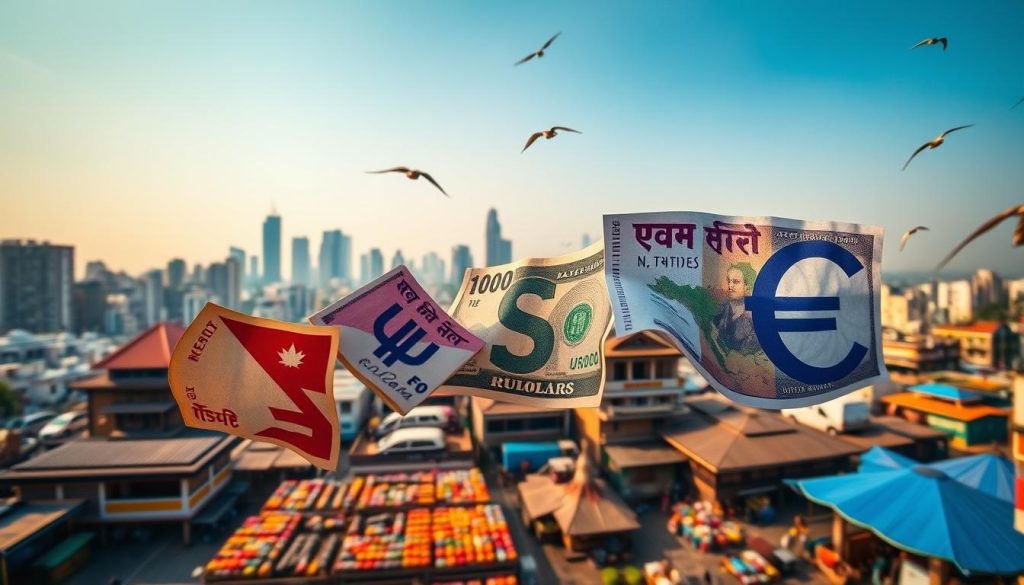
Daily Fluctuations and Fixed Rates
Exchange rates are dynamic, meaning they can change multiple times a day. For example, the Nepalese Rupee’s value against the US Dollar or Euro can shift based on market conditions. However, there’s a fixed rate for the Indian Rupee (INR), which is unique to this region.
To stay updated, check the Nepal Rastra Bank’s website for the latest rates. This authoritative source provides accurate and real-time information, helping you plan your transactions wisely.
Timing Your Currency Exchange
Timing is everything when it comes to currency conversions. Rates can vary significantly from one day to the next, so monitoring trends can help you identify the best time to exchange your money. For instance, rates are often more favorable during weekdays when markets are active.
Here are a few tips to maximize your exchange:
- Compare rates at banks, authorized counters, and online tools.
- Avoid exchanging large amounts at airports, as their rates are typically less favorable.
- Plan ahead to avoid last-minute exchanges, which may limit your options.
“A little research can save you a lot of money when it comes to currency exchange.”
Impact on Your Travel Budget
Daily fluctuations in exchange rates can directly affect your travel budget. For example, a slight change in the rate could mean paying more for accommodations or meals. By staying informed and timing your exchanges strategically, you can stretch your budget further.
Remember, a favorable transaction isn’t just about the rate—it’s also about minimizing fees and choosing reliable sources. With these insights, you’ll be well-prepared to navigate currency conversions like a pro.
Securing the Best Rates: Exchanging Money in Nepal
Getting the best exchange rates can significantly impact your travel budget. Whether you’re converting USD, EUR, or GBP, knowing where to exchange your money safely and cost-effectively is essential. This section will guide you through the best options, from banks to authorized counters, and help you avoid unnecessary fees.
Banks, Authorized Counters, and Airport Options
Banks like Standard Chartered and Himalayan Bank are reliable choices for currency exchange. They offer competitive rates and require your passport for identification. Authorized counters in tourist areas like Thamel are also convenient, often displaying current rates for comparison.
Airport counters, while accessible upon arrival, tend to have less favorable rates and higher fees. If you must exchange at the airport, limit the amount to cover immediate expenses and convert the rest later in the city.
Comparing Exchange Options
Here’s a quick comparison of the most common exchange methods:
| Option | Pros | Cons |
|---|---|---|
| Banks | Safe, competitive rates, reliable | May have limited hours |
| Authorized Counters | Convenient, transparent rates | Rates may vary slightly |
| Airport Counters | Accessible upon arrival | Higher fees, less favorable rates |
Street money changers, while tempting, pose risks of scams and counterfeit bills. Always verify rates and choose licensed providers to ensure a secure transaction.
“A little research can save you a lot of money when it comes to currency exchange.”
By planning ahead and comparing options, you can maximize your foreign currency conversion and enjoy a smoother travel experience.
Using ATMs in Nepal: Access, Limits, and Fees
Accessing cash through ATMs is a convenient way to manage your finances while traveling. In urban areas like Kathmandu and Pokhara, ATMs are widely available, making it easy to withdraw local currency. However, understanding withdrawal limits and fees is essential to avoid unnecessary costs.
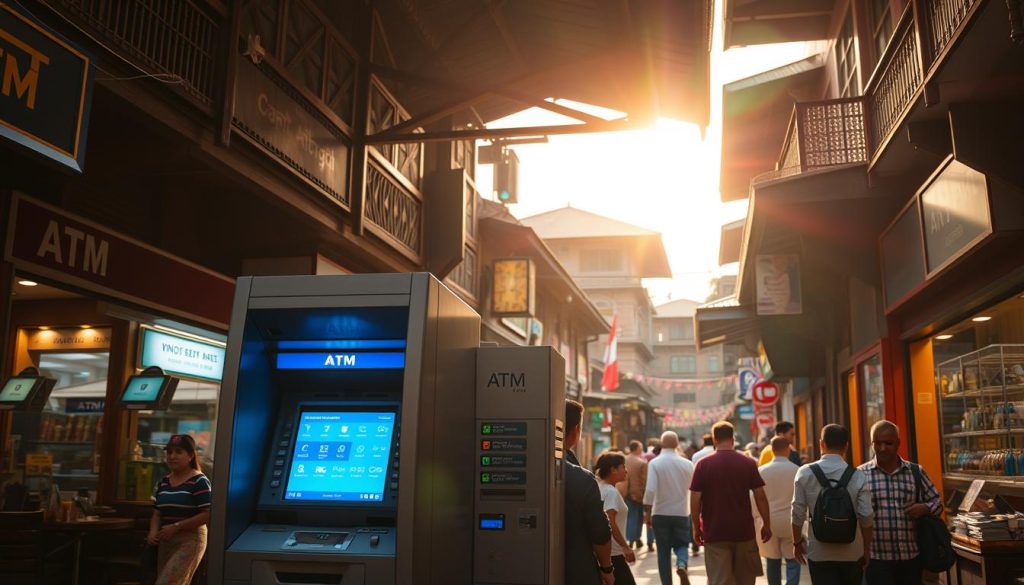
Most ATMs allow withdrawals between Rs 10,000 and Rs 35,000 per transaction, with a daily limit of Rs 100,000. Foreign cards are accepted, but fees can range from Rs 500 to Rs 800 per withdrawal. Carrying both a credit card and a debit card ensures you have backup options if one doesn’t work.
Top ATMs for International Travelers
Banks like Standard Chartered and Nabil Bank operate reliable ATMs for international visitors. These machines are commonly found in tourist areas, airports, and shopping malls. Always check for the logos of Visa, Mastercard, or other supported networks before inserting your card.
Here’s a quick comparison of popular ATM options:
| Bank | Withdrawal Limit | Fees |
|---|---|---|
| Standard Chartered | Rs 35,000 | Rs 700 |
| Nabil Bank | Rs 30,000 | Rs 600 |
| Global IME Bank | Rs 25,000 | Rs 750 |
Avoiding Common ATM Pitfalls
When using ATMs, always choose well-lit and secure locations. Avoid street machines, as they may not be reliable. Check for skimming devices and shield your PIN during transactions. Additionally, notify your bank about your travel plans to prevent your card from being blocked.
In remote or trekking areas, ATMs are scarce. Carry extra cash to cover expenses. By planning ahead and using trusted ATMs, you can ensure a smooth financial experience during your trip.
Credit and Debit Card Payments in Nepal
Using credit and debit cards in Nepal can simplify your travel expenses, but it’s essential to know where and how they’re accepted. While cards are convenient, understanding the limitations and fees will help you make informed decisions.
Where Cards Are Accepted
Major establishments like hotels, upscale restaurants, and tourist shops in cities such as Kathmandu and Pokhara widely accept Visa, Mastercard, and American Express. These venues often have card machines, making transactions seamless.
However, in smaller towns or local markets, cash remains the preferred payment method. Many smaller vendors and rural areas lack the infrastructure for card transactions. Always carry some cash as a backup.
Understanding Transaction Fees
When using cards, be aware of additional fees. Many merchants charge a 3-4% surcharge to cover bank processing costs. This fee is often added to your bill, so check before confirming the payment.
Here’s a quick breakdown of what to expect:
- Hotels and restaurants: 3-4% surcharge on card payments.
- ATMs: Rs 500-800 per withdrawal for international cards.
- Dynamic Currency Conversion: Avoid this option, as it often results in poor exchange rates.
“Always ask about additional fees before using your card to avoid surprises.”
For high-end establishments, cards are a reliable payment method. However, smaller vendors may not accept them, so planning ahead is key. Carry a mix of cash and cards to ensure you’re prepared for any situation.
In case of card machine failures, having backup cash is crucial. Notify your bank about your travel plans to prevent your card from being blocked. By understanding where and how to use cards, you can enjoy a hassle-free financial experience.
Digital Payments and Mobile Wallet Adoption
Mobile wallets are transforming the way people handle transactions in traditionally cash-based economies. Even in regions where cash has been king, digital payment systems are gaining traction. These platforms offer a modern, convenient alternative to carrying physical money.

Popular apps like eSewa, Khalti, IME Pay, and Fonepay are leading this shift. These platforms allow users to pay bills, transfer money, and even shop online with just a few taps. For locals, this has become a game-changer in managing daily finances.
Popular Wallet Options
eSewa is one of the most widely used digital payment apps. It supports a range of services, from utility bill payments to mobile recharges. Khalti offers similar features, with added benefits like discounts on transactions. IME Pay and Fonepay are also popular, especially for peer-to-peer transfers.
These apps are user-friendly and accessible through their respective websites or mobile stores. However, they often require a local phone number for registration, which can be a hurdle for international travelers.
Challenges for International Travelers
While digital payments are convenient, they come with limitations for visitors. Most apps require a local SIM card and phone number, which not all travelers have. Additionally, some platforms may not support international cards, limiting their usability.
In urban areas, digital payment adoption is high, but rural regions still rely heavily on cash. This means you’ll need to carry both forms of payment for flexibility. Planning ahead ensures you’re prepared for any situation.
“Digital payments are reshaping financial habits, but cash remains essential in many areas.”
To make the most of your trip, consider using a mix of digital and physical payment methods. Mobile wallets are great for convenience, but having cash on hand is crucial in remote locations. By balancing both, you’ll enjoy a seamless and stress-free experience.
Managing Tipping, Service Charges, and Budgeting
Navigating tipping customs and service charges can make your trip smoother and more enjoyable. Understanding local expectations helps you avoid overpaying while showing appreciation for good service. This section covers everything you need to know about tipping, budgeting, and handling additional charges.
Standard Tipping Guidelines for Guides and Porters
Tipping is a common practice, especially for guides and porters. For guides, a daily tip of NPR 500-1,000 is standard, depending on the level of service. Porters typically receive NPR 300-500 per day. These amounts show gratitude for their hard work and support during your journey.
In tourist areas, tipping is expected and often included in service charges. However, in remote regions, it’s more about personal discretion. Always carry smaller denominations like NPR 20, 50, or 100 for tips, as breaking larger notes can be challenging.
Service Charges and VAT in Restaurants and Hotels
Many restaurants and hotels automatically add a 10% service charge and 13% VAT to your bill. This means you don’t need to leave an additional tip unless you feel the service was exceptional. Always check your bill to avoid double-paying for services.
In smaller establishments, these charges may not apply. In such cases, a tip of 5-10% is appreciated. This flexibility allows you to manage your budget while respecting local customs.
Budgeting Tips for a Stress-Free Trip
Planning your budget in advance helps you avoid unexpected costs. Allocate funds for meals, accommodations, permits, and tips. For example, daily meals in trekking areas range from NPR 400-1,000, while permits can cost NPR 2,000-5,000.
Carry a mix of cash and cards to cover all expenses. In remote areas, cash is essential, as ATMs may be unreliable. Keep emergency funds separate from your daily spending money for added security.
“A well-planned budget ensures you can focus on enjoying your adventure without financial stress.”
Balancing Cash and Card Payments
While cards are convenient in cities, cash is king in rural areas. Use cards for major expenses like hotels and restaurants, but always have cash on hand for tips and smaller purchases. This balance ensures you’re prepared for any situation.
By understanding local tipping practices and managing your budget wisely, you can make your trip more enjoyable and stress-free. A little preparation goes a long way in ensuring a smooth and memorable experience.
Nepal: Ultimate Travelers Guide to Currencies & Payments
Navigating the financial landscape of a new country can be both exciting and challenging. Understanding the local currency and payment methods is essential for a smooth trip. From cash transactions to digital payments, being prepared ensures you can focus on enjoying your adventure.
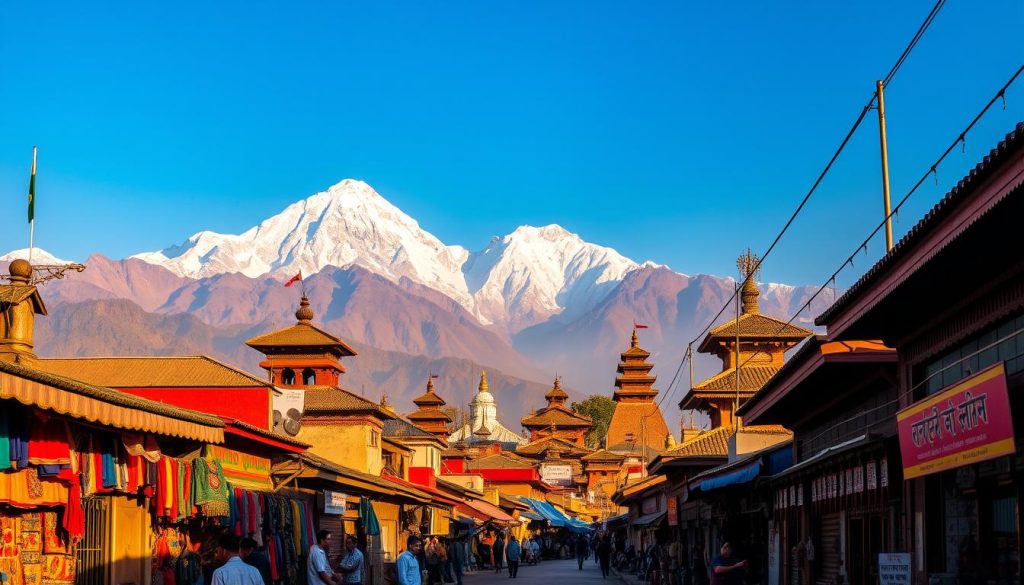
One of the key takeaways is the importance of carrying cash, especially in remote areas. While cities like Kathmandu and Pokhara offer modern payment options, smaller towns rely heavily on physical currency. Having a mix of denominations ensures you’re ready for any situation.
Currency exchange is another critical aspect. Timing your exchanges and comparing rates can save you money. Avoid airport counters for large transactions, as their rates are often less favorable. Instead, opt for banks or authorized counters in the city.
“A little preparation goes a long way in ensuring a stress-free financial experience.”
For tourists, understanding tipping customs is equally important. Guides and porters appreciate small gestures of gratitude, while restaurants and hotels often include service charges in the bill. Always check for these to avoid double-paying.
Finally, balancing cash and card payments is crucial. While cards are convenient in urban areas, cash is essential in rural regions. By planning ahead and staying informed, you can make the most of your trip to this unique destination.
Crafting a Smart Financial Strategy for Your Nepali Adventure
Planning your finances wisely can make or break your adventure in a foreign country. A smart strategy ensures you’re prepared for any situation, whether you’re exploring bustling cities or remote trekking trails. By combining multiple payment methods and planning ahead, you can enjoy a stress-free experience.
Multi-Payment Methods for Flexibility
Using a mix of cash, cards, and travel debit cards is the key to financial flexibility. In urban areas, cards are widely accepted, but cash remains essential in rural regions. Travel cards like Wise simplify multi-currency transactions, helping you avoid high fees.
Here’s a quick comparison of popular payment options:
| Method | Pros | Cons |
|---|---|---|
| Cash | Widely accepted, no fees | Risk of loss or theft |
| Credit/Debit Cards | Convenient in cities | High fees in rural areas |
| Travel Debit Cards | Low fees, multi-currency support | Limited acceptance in remote areas |
Planning Ahead for Remote Areas
In remote trekking regions, ATMs are scarce, and card acceptance is limited. Always carry extra cash to cover expenses like meals, permits, and tips. Store emergency funds separately to ensure access in case of loss or theft.
Here are some tips for managing finances in remote areas:
- Withdraw cash in cities before heading to rural areas.
- Carry smaller denominations for easier transactions.
- Notify your bank about your travel plans to avoid card blocks.
“A well-planned financial strategy ensures you can focus on your adventure without worrying about money.”
By balancing cash and card payments, you’ll be prepared for any situation. Whether you’re in a bustling city or a remote trekking area, a smart financial plan makes your journey smoother and more enjoyable.
Conclusion
Navigating financial systems in a new place requires preparation and insight. Understanding the local currency nepal and its dynamics is essential for a smooth experience. Whether you’re in a bustling city or a remote village, carrying the right mix of cash, cards, and digital payment options ensures flexibility.
The rupee remains the backbone of daily transactions, especially in rural areas where cash is king. In cities, digital payments are gaining traction, but it’s wise to adapt to both methods. Always plan ahead to avoid surprises, and keep an eye on exchange rates to maximize your budget.
This guide serves as a handy reference for managing your finances effectively. Stay informed about local practices and embrace the change in payment methods. With the right strategy, you can focus on enjoying your journey without financial stress.
The above is subject to change.
Check back often to TRAVEL.COM for the latest travel tips and deals.

